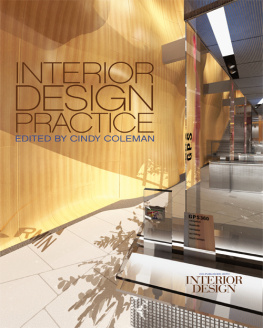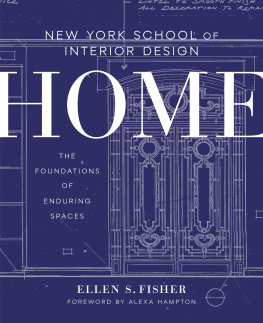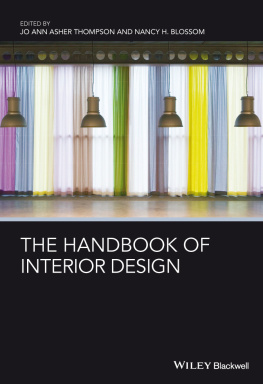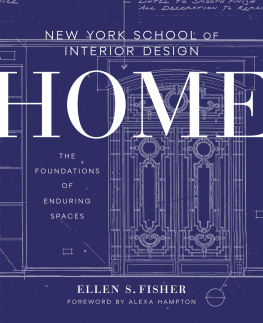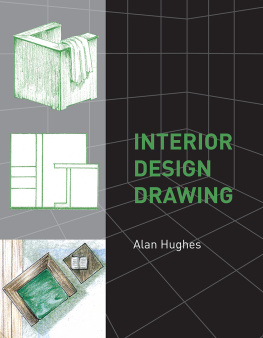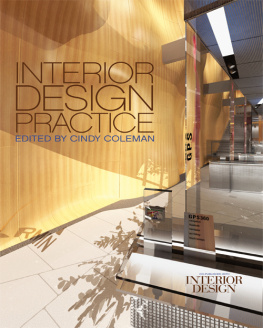INTERIOR
DESIGN
PRACTICE
EDITED BY
Cindy Coleman

2010 Cindy Coleman
All rights reserved. Copyright under Berne Copyright Convention, Universal Copyright Convention, and Pan-American Copyright Convention. No part of this book may be reproduced, stored in a retrieval system, or transmitted in any form, or by any means, electronic, mechanical, photocopying, recording, or otherwise, without prior permission of the publisher.
14 13 12 11 10 5 4 3 2 1
Published by Allworth Press
An imprint of Allworth Communications, Inc.
10 East 23rd Street, New York, NY 10010
Cover design by Geoff Bock, Interior Design magazine
Interior design by Mary Belibasakis
Page composition/typography by SR Desktop Services, Ridge, NY
ISBN: 978-1-58115-675-1
eBook ISBN: 978-1-58115-740-6
Library of Congress Cataloging-in-Publication Data
Interior design practice / edited by Cindy Coleman.
p. cm.
ISBN 978-1-58115-675-1
1. Interior decorationPractice. I. Coleman, Cindy.
NK2116.I59 2010
747.068dc22 2009044555
Printed in the United States of America
Contents
S E C T I O N
I
Background
Evolution of the Profession
BY C INDY C OLEMAN
Introduction
I nterior designers can trace their profession to many who preceded them, from the cave painters at Lascaux to the creators of the frescoed interiors at Pompeii to the holistic architecture, interiors, and furnishings of Robert Adam and Thomas Jefferson in the eighteenth century, and Frank Lloyd Wright in the twentieth.
In the mid-nineteenth century, during the Industrial Revolution, the farm economy, though still robust, was gradually supplanted by a new industrial economy centered in or near the great, developing American cities of New York, Boston, and Chicago. The transition from farm to industry allowed Americans to see their houses as more than shelter and a place to sleep when work outdoors was done. Industrial workers days were not necessarily shorter than those of farmers. However, for industrial workers and city dwellers in particular, home became a refuge that provided physical comfort and even aesthetic pleasure in contrast to the noisy, gritty, and physically exhausting atmosphere of the factory.
As women had more time to spend on the comforts of home, the large department stores of England and America developed and included sections devoted to drapery and upholstery. Specialty retailers included Liberty of London for fabrics and Tiffany and Affiliated Artists in New York, which produced lamps, vases, and other finely crafted decorative items.
At the end of the nineteenth century in England and America, the arts and crafts movement developed as a direct response to the Industrial Revolution. Its members, including William Morris, Charles Voysey, and Gustav Stickley, celebrated handcraft and deplored the social conditions, as well as the machine-made designs, that the Industrial Revolution had created. The arts and crafts movement created small workshops devoted to woodworking, pottery, and weaving and brought together artists and architects to study the interiors as well as the exteriors of buildings. Design integrity within the contemporary cultural and social context was the concern not only of the arts and crafts movement but also of other groups, including the Wiener Werkstratte and the Bauhaus, which developed and flourished in the twentieth century.
Sensitivity to the role of design in society is as relevant in the twenty-first century as it was at the dawn of the twentieth. Some, in fact, have referred to the twenty-first century as the design century. Today, design is relevant as never before, particularly to the world of work.
Following World War II, business theories and practices began to evolve and proceeded at a manageable pace; with the widespread use of computers in the 1980s, that evolution picked up speed and continues to do so today, when the only organizational constant is change. After World War II, the residential and corporate branches of the interior design profession began to move on separate tracks. Both have traveled rapidly, but each in a different direction. The interior designers role as a professional consultant to business and organizations will be the focus of this chapter. It is important to emphasize, however, that design is a global language that transcends home, institution and workplace, geography, and culture. To be a designer is to understand what all men and women have in commontheir humanity.
Interior Design Emerges as a Profession: 1900 to 1930
The formal study of interior design began in the United States at the end of the nineteenth century. Programs and curricula typically developed in art schools; at the great land-grant colleges of the Midwest, which were open to women and also boasted strong programs in home economics; and within academic programs in architecture, primarily at East Coast universities.
When interior design actually became recognized as a profession is a subject for debate. Some scholars believe that interior design was not acknowledged as an independent profession until 1897, when Edith Wharton and Ogden Codman, Jr., published The Decoration of Houses. The authors are considered the first to define the profession as it is viewed today by clarifying the difference between interior decoration, which deals with surface treatments, and interior design, which encompasses the design of interior spaces.
Elsie de Wolfe, a contemporary of Whartons and a disciple of her approach, is considered to be one of Americas first professional interior designers. Her expertise, however, was on the side of interior decoration, which she used with great skill in the creation of interiors for the industrialist Henry Clay Frick and other wealthy New York families. She also accepted commissions from the prominent Beaux-Arts architect Stanford White. Early twentieth-century women who are also considered among the first design professionals are Nancy McClelland, who brought design services to the general public through the decorating department she established at Wanamakers department store in Manhattan; and Eleanor McMillen, whose McMillen, Inc., is considered to be Americas first interior decorating firm.
By the turn of the twentieth century, the Industrial Revolution had reached full maturity. Daily life in the developed world had become increasingly mechanized, and Thomas Edisons electric light bulb was adding time to the workday and changing the nature of work. At the same time, the seeds of the Information Agea century in the futurewere being planted with Bells telephone in 1876 and Edisons subsequent inventions of the telephone transmitter, the stock ticker, the phonograph, and the movie camera. During the early part of the twentieth century, there was little if any distinction between residential and nonresidential interior design. It would not be until after World War II that North Americans would become open to the idea of hiring design professionals for their houses and offices as well. And as the century began, the archetype of the workplace was the assembly line that Henry Ford created to produce the Model T.
An early business theorist, Frederick W.Taylor, extended the assembly line from the product to the worker. Considered to be industrys first efficiency expert, Taylor conducted time-study experiments that he developed into the concept he called scientific management. In Taylors view, human workers couldand shouldfunction as mechanically as machines. If workers were discouraged from thinking creatively and independently and completely removed from decisionmaking, and if work was broken down into its simplest units, with all members of a single group of workers dedicated to identical tasks, efficiency was the result. Taylors methods, developed for the factory, eventually found their way into offices, along with typewriters, calculators, and switchboards and the women and recently arrived European immigrants who were hired to operate them.
Next page
